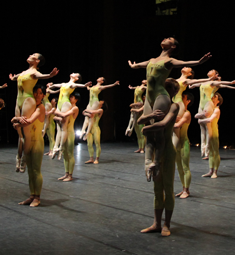More funds and less tax help artists
In a recession, it is inevitable there will be arts funding cuts, but what are these going to be and how will they impact art’s ability to sustain and invigorate society? With rumoured cuts of 25-40%, arts organisations are facing funding uncertainty in three main areas: government, local authorities and private sources.
I am encouraged that Scotland seems to have minimised such cuts; the government’s Culture and External Affairs budget has acknowledged how vital creative industries are in aiding economic recovery. But I am worried by the emphasis on “creative industries,” rather than on the arts. Although Creative Scotland—which administers state and lottery funding for the arts, screen and creative industries—will be subject to the 3% efficiency savings required of all public bodies, its £60mn core budget will not be reduced, thanks to the £700,000 it saved by amalgamating the Scottish Arts Council and Screen Scotland.
But Scotland’s National Collections—responsible for key cultural objects—will be affected by the 3% cut, although the government intends to preserve free entry to museums. There will also be continued support for Arts & Business Scotland—which connects firms and individuals to cultural organisations—and the Cultural Enterprise Office—which helps creative and cultural businesses and individuals—in recognition of their significant role in “encouraging private investment in the arts and creative industries”.
In England, all 850 organisations regularly funded by the Arts Council will have this support cut 6.9% over the years 2011 and 2012, with even bigger reductions looming. Meanwhile, the fate of smaller UK organisations that rely on public funding will be announced when local authorities make their own cuts. The arts are likely to be considered an easy target.
Media hype about the fortunes made by such artists as Damien Hirst and Tracy Emin has given many people the impression that their taxes are spent on boosting the affluence of such individuals, and that the arts are over indulged. In fact, these fortunes are made from private-sector clients not the public purse, and are surely contributing income tax.
Most artists actually work very hard for little or no financial reward. Even if they do not earn enough to pay income tax, they still have to pay VAT on materials, unless they voluntarily register for VAT in order to claim it back, in which case they have to add it to the price of their work, which contributes to the public purse if it is sold.
To date, UK government subsidies have helped make theatre, music and the visual arts more accessible and affordable to the public, and have generated income as well as raising international perceptions of contemporary Britain. However, subsidised work has to be tailored to the catch phrases that attract funding, and publicly subsidised galleries are not focused on selling artists’ work. The best way for an artist to survive is to sell work or be commissioned.
Although the government seems to be pinning its hopes on a new generation of philanthropists, it could give artists a better chance to make a living and encourage individuals and firms to invest in art by reducing, or even abolishing, VAT on purchases and sales of art work and materials.
Most of my work in Japan has been commissioned public sculptures, and none of it has been through arts funding. Several sculptures for city or town sites were funded through local authority redevelopment budgets. Sculptures for city streets, public parks, housing and office developments, hotels, restaurants, and universities are often paid for out of the amenities’ budgets for those projects, or sponsored by a firm that wants to be associated with the site to commemorate a special person or event, as with my sculpture for the British Embassy Tokyo that was paid for by Shell.
More private and corporate commissions in the UK would help to extend the range of work reaching the public domain. And both the Japanese and UK governments could help encourage more commissions of public art by extending and simplifying tax relief for commissioner and sponsor alike.
The arts contribute to the economy through imagination, innovation, intellectual stimulation and discussion, as well as with the income generated. UK government figures reveal that its creative industries account for over 1mn jobs and bring in £112.5bn to the economy. It is also true that, without art, society has no soul.
Investing in living artists is one of the few opportunities for those with even small amounts of money, or time, to put it to good use, not just by buying or commissioning their work, but also by interacting, encouraging and promoting them; enriching and endorsing investors’ tastes; and helping improve the value of their investment by helping their chosen artists to succeed.
Hironori Katagiri and I have spent more than 20 years generating opportunities for our own and other artists’ work in the UK and Japan, and are very grateful to everyone who has supported us. At our recent London exhibition opening, a shy businessman walked in off the street and bought a small sculpture. Although a modest sale, the chance to talk to him about our work, and the encouragement he gave us was invaluable.
Ukishima Sculpture Studio website: www.ukishima.net





